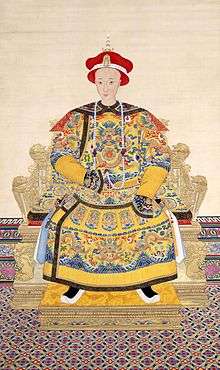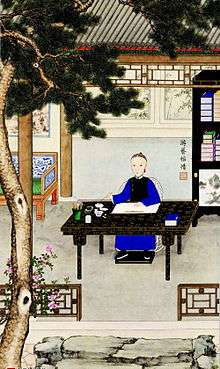Tongzhi Emperor
| Tongzhi Emperor 同治帝 | |||||||||||||||||
|---|---|---|---|---|---|---|---|---|---|---|---|---|---|---|---|---|---|
 | |||||||||||||||||
| 10th Emperor of the Qing Dynasty | |||||||||||||||||
| Reign | 11 November 1861 – 12 January 1875 | ||||||||||||||||
| Predecessor | Xianfeng Emperor | ||||||||||||||||
| Successor | Guangxu Emperor | ||||||||||||||||
| Regents |
Sushun, Zaiyuan, Duanhua and five other officials (1861) Empress Dowager Ci'an and Empress Dowager Cixi (1861–1875) | ||||||||||||||||
| Born |
27 April 1856 Forbidden City, Beijing, China | ||||||||||||||||
| Died |
12 January 1875 (aged 18) Forbidden City, Beijing, China | ||||||||||||||||
| Burial | Eastern Qing Tombs, Zunhua, China | ||||||||||||||||
| Empress | Empress Xiaozheyi | ||||||||||||||||
| Issue | Xuantong Emperor (Adoptive) | ||||||||||||||||
| |||||||||||||||||
| House | Aisin Gioro | ||||||||||||||||
| Father | Xianfeng Emperor | ||||||||||||||||
| Mother | Empress Dowager Cixi | ||||||||||||||||
| Tongzhi Emperor | |||||||||
| Chinese | 同治帝 | ||||||||
|---|---|---|---|---|---|---|---|---|---|
| |||||||||
The Tongzhi Emperor (27 April 1856 – 12 January 1875), born Zaichun of the Aisin Gioro clan,[1] was the tenth emperor of the Manchu-led Qing dynasty, and the eighth Qing emperor to rule over China. His reign, from 1861 to 1875, which effectively lasted through his adolescence, was largely overshadowed by the rule of his mother, Empress Dowager Cixi. Although he had little influence over state affairs, the events of his reign gave rise to what historians call the "Tongzhi Restoration", an unsuccessful attempt to stabilise and modernise China.
Life
The only surviving son of the Xianfeng Emperor and Empress Dowager Cixi, the Tongzhi Emperor attempted political reform in the period of the Tongzhi Restoration. His first regnal name was Qixiang (祺祥; Manchu: Fengšengge Sabingga), but this name was later abandoned by Cixi in favour of "Tongzhi", a contraction of the classical phrase tong gui yu zhi (同归与治; 同歸與治), which means "restoring order together". An alternate interpretation reads it as "mother and son co-emperors" (母子同治天下), which fits the state of affairs, as the empress dowager wielded real power and ruled behind the scenes. The traditional Chinese political phrase "attending audiences behind a curtain" (垂帘听政; 垂簾聽政; chuí lián tīng zhèng) was coined to describe Cixi's rule through her son.
The Tongzhi Emperor became emperor at the age of five upon the death of his father, the Xianfeng Emperor. His father's choice of regent, Sushun, was removed in favour of a partnership between his mother Empress Dowager Cixi, Empress Dowager Ci'an, and his sixth uncle Prince Gong.
While there had most likely been hopes that the Tongzhi Emperor would become a leader like the Kangxi Emperor (who ascended the throne as a child in 1661), those hopes would soon come to naught, as the Tongzhi Emperor grew up to become an obstinate and dissolute young man.
In the fall of 1872, the teenage emperor married Empress Xiaozheyi and several concubines. The Tongzhi Emperor apparently had wanted to take up power immediately, prompting a quarrel at court regarding the dismantling of the regency and the timing of it. However, the two empress dowagers stuck by the intended date of February 23, 1873.[2]
The day after the Tongzhi Emperor took up the reins of power, the foreign powers requested an audience with the teenage emperor. The request precipitated a sharp disagreement between the ministers at the foreign legations, who made it clear that they would not perform the ritual kowtow to the emperor, and the Zongli Yamen (foreign affairs ministry), regarding the protocol to be observed. The Qing government was also loath to hold the audience within the confines of the Forbidden City, eventually settling on the "Pavilion of Purple Light" at one of the lakeside palaces to the west of the Forbidden City, which is now part of Zhongnanhai.[3] The audience was finally held on 29 June 1873. After the audience, however, the foreign representatives made it clear their annoyance of being received at a hall initially used by the Qing emperors to receive envoys of tributary states.
In the fall of 1874, the Tongzhi Emperor got into a clash with his ministers, which included his two uncles, Prince Gong and Prince Chun, largely over the emperor's plans to rebuild the Old Summer Palace at a time in which the empire was bankrupt, and over his dissolute behavior. The emperor reacted by firing the ministers, but Empress Dowagers Ci'an and Cixi intervened, and he had them reinstated. That December, it was announced that he was ill with smallpox, and the empress dowagers resumed the regency. He died on 12 January 1875, leaving no sons to succeed him.
The Tongzhi Emperor's death left the court in a succession crisis, as, although he was childless, his empress was reportedly pregnant. Eventually, the empress dowagers designated the Tongzhi Emperor's three-year-old cousin, Zaitian, as the heir to the throne. Zaitian was biologically Prince Chun's son, but was symbolically adopted as the Xianfeng Emperor's son to make him eligible to succeed the Tongzhi Emperor. Zaitian was thus enthroned as the Guangxu Emperor, with Empress Dowagers Ci'an and Cixi resuming their roles as regents. The Tongzhi Emperor's empress died a few months later.
Family
- Spouses
| Title / Posthumous title | Name | Born | Died | Father | Notes |
|---|---|---|---|---|---|
| Empress Xiaozheyi 孝哲毅皇后 | Lady Alute 阿魯特氏 | 25 July 1854 | 27 March 1875 | Coci (崇綺; 1829–1900) of the Alute clan | Married the Tongzhi Emperor and became Empress in 1872; Also known as the Jiashun Empress (嘉順皇后) |
| Imperial Noble Consort Shushen 淑慎皇貴妃 | Lady Fuca 富察氏 | 24 December 1859 | 13 April 1904 | Fengxiu (鳳秀) of the Fuca clan | Became Consort Hui (慧妃) in 1872; Promoted to Imperial Noble Consort Dunyi (敦宜皇貴妃) in 1874; Honoured as Imperial Noble Consort Dunyi Rongqing (敦宜榮慶皇貴妃) in 1894 |
| Imperial Noble Consort Gongsu 恭肅皇貴妃 | Lady Alute 阿魯特氏 | 20 September 1857 | 14 April 1921 | Saišangga (賽尚阿; 1794–1875) of the Alute clan | Imperial Noble Consort Zhuanghe was actually Empress Xiaozheyi's aunt even though she was three years younger than the Empress; Became Imperial Concubine Xun (珣嬪) in 1872; Promoted to Consort Xun (珣妃) in 1874 by the Guangxu Emperor; Promoted to Noble Consort Xun (珣貴妃) in 1894; Promoted to Dowager Imperial Noble Consort Xun (皇考珣皇貴妃) in 1908 by the Xuantong Emperor; Honoured as Dowager Imperial Noble Consort Zhuanghe (皇考莊和皇貴妃) in 1913 |
| Imperial Noble Consort Xianzhe 獻哲皇貴妃 | Lady Hešeri 赫舍里氏 | 2 July 1856 | 5 February 1932 | Chongling (崇齡) of the Hešeri clan | Became Imperial Concubine Yu (瑜嬪) in 1872; Promoted to Consort Yu (瑜妃) in 1874 by the Guangxu Emperor; Promoted to Noble Consort Yu (瑜貴妃) in 1894; Promoted to Dowager Imperial Noble Consort Yu (皇考瑜皇貴妃) in 1908 by the Xuantong Emperor; Honoured as Dowager Imperial Noble Consort Jingyi (皇考敬懿皇貴妃) in 1913; A daily routine of the concubine is recorded in a memoir of a palace eunuch[4] |
| Imperial Noble Consort Dunhui 敦惠皇貴妃 | Lady Silin-Gioro 西林覺羅氏 | 6 September 1856 | 18 May 1933 | Luolin (羅霖) of the Silin-Gioro clan | Became Noble Lady Jin (瑨貴人) in 1872; Promoted to Imperial Concubine Jin (瑨嬪) in 1874 by the Guangxu Emperor; Promoted to Consort Jin (瑨妃) in 1895; Promoted to Dowager Noble Consort Jin (皇考瑨貴妃) in 1908 by the Xuantong Emperor; Promoted to Dowager Imperial Noble Consort Ronghui (皇考榮惠皇貴太妃) in 1913 |
- Adopted son
| Title / Posthumous title | Name | Born | Died | Father | Notes |
|---|---|---|---|---|---|
| Xuantong Emperor 宣統帝 | Puyi 溥儀 | 7 February 1906 | 17 October 1967 | Zaifeng | Born after the Tongzhi Emperor died, but was symbolically adopted in 1908 as a son and heir to both the Tongzhi Emperor and Guangxu Emperor; Enthroned on 2 December 1908 |
Portraits
Ancestry
| Ancestors of the Tongzhi Emperor | ||||||||||||||||||||||||||||||||||||||||||||||||||||||||||||||||||||||||||||||||||||||||||||||||||||||||||||||||||||||||||||||||||||||||||||||||||||||||||||||||||||||||||||||||||||||||||||||||||||||||||||||||||||||||||||||||||||||||||||||||||||||||||||||||||||||||||||||||||||||||||||||||||||||||||||||||||||||||||||||||||||||||||||||||||||||
|---|---|---|---|---|---|---|---|---|---|---|---|---|---|---|---|---|---|---|---|---|---|---|---|---|---|---|---|---|---|---|---|---|---|---|---|---|---|---|---|---|---|---|---|---|---|---|---|---|---|---|---|---|---|---|---|---|---|---|---|---|---|---|---|---|---|---|---|---|---|---|---|---|---|---|---|---|---|---|---|---|---|---|---|---|---|---|---|---|---|---|---|---|---|---|---|---|---|---|---|---|---|---|---|---|---|---|---|---|---|---|---|---|---|---|---|---|---|---|---|---|---|---|---|---|---|---|---|---|---|---|---|---|---|---|---|---|---|---|---|---|---|---|---|---|---|---|---|---|---|---|---|---|---|---|---|---|---|---|---|---|---|---|---|---|---|---|---|---|---|---|---|---|---|---|---|---|---|---|---|---|---|---|---|---|---|---|---|---|---|---|---|---|---|---|---|---|---|---|---|---|---|---|---|---|---|---|---|---|---|---|---|---|---|---|---|---|---|---|---|---|---|---|---|---|---|---|---|---|---|---|---|---|---|---|---|---|---|---|---|---|---|---|---|---|---|---|---|---|---|---|---|---|---|---|---|---|---|---|---|---|---|---|---|---|---|---|---|---|---|---|---|---|---|---|---|---|---|---|---|---|---|---|---|---|---|---|---|---|---|---|---|---|---|---|---|---|---|---|---|---|---|---|---|---|---|---|---|---|---|---|---|---|---|---|---|---|---|---|---|---|---|---|---|---|---|---|---|---|---|---|---|---|---|---|---|---|---|---|---|---|---|---|
| ||||||||||||||||||||||||||||||||||||||||||||||||||||||||||||||||||||||||||||||||||||||||||||||||||||||||||||||||||||||||||||||||||||||||||||||||||||||||||||||||||||||||||||||||||||||||||||||||||||||||||||||||||||||||||||||||||||||||||||||||||||||||||||||||||||||||||||||||||||||||||||||||||||||||||||||||||||||||||||||||||||||||||||||||||||||
See also
References
Citations
- ↑ http://www.dartmouth.edu/~qing/WEB/TSAI-CH'UN.html
- ↑ Seagrave, Sterling Dragon Lady: the Life and Legend of the Last Empress of China (Knopf, 1992), pg. 130-131
- ↑ Seagrave, pg. 131
- ↑ Forbidden City: The Great Within, Second Edition. May Holdsworth, Caroline Courtauld. ISBN 962-217-792-1.
- ↑ Qing Shi Gao vol. 214.
Sources
- The draft history of the Qing dynasty 《清史稿》卷二百十四.列傳一.后妃傳.
- Sterling Seagrave, Dragon Lady ISBN 0-679-73369-8.
- Daily life in the Forbidden City, Wan Yi, Wang Shuqing, Lu Yanzhen. ISBN 0-670-81164-5.
- Forbidden City: The Great Within, Second Edition. May Holdsworth, Caroline Courtauld. ISBN 962-217-792-1.
Further reading
| Wikimedia Commons has media related to Tongzhi Emperor. |
- Jung Chang, Empress Dowager Cixi: The Concubine Who Launched Modern China, (2013) ISBN 978-0-307-27160-0.
- Mary Clabaugh Wright. The Last Stand of Chinese Conservatism: The T'ung-Chih Restoration, 1862-1874. (Stanford: Stanford University Press, 1957).
| Tongzhi Emperor Born: 27 April 1856 Died: 12 January 1875 | ||
| Regnal titles | ||
|---|---|---|
| Preceded by The Xianfeng Emperor |
Emperor of China 1861–1875 |
Succeeded by The Guangxu Emperor |
